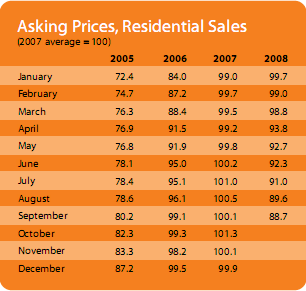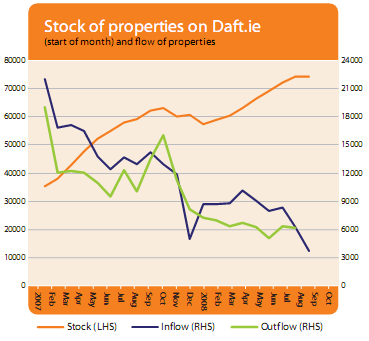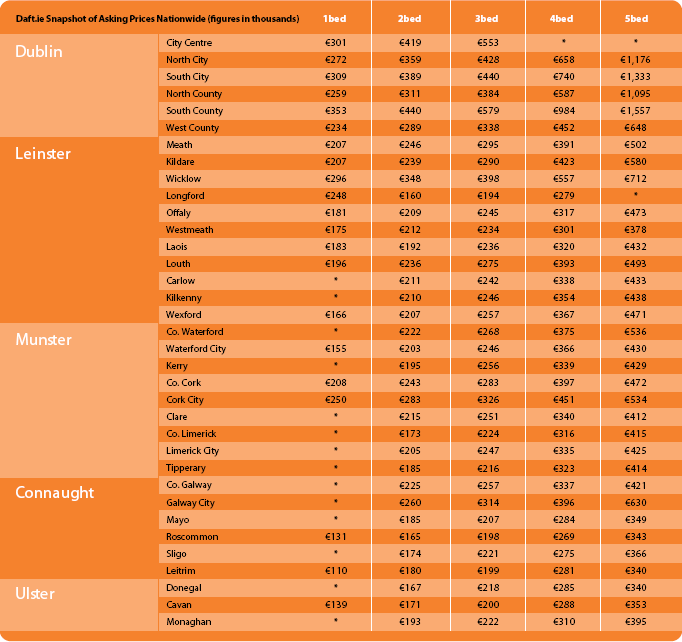As safe as houses? Not at the moment
Daft Reports
- Ronan Lyons (House Price, Q1 2024)
- Ronan Lyons (Rental Price, Q4 2023)
- Ronan Lyons (House Price, Q4 2023)
- Ronan Lyons (Rental Price, Q3 2023)
- Ronan Lyons (House Price, Q3 2023)
- Ronan Lyons (Rental Price, Q2 2023)
- Ronan Lyons (House Price, Q2 2023)
- Ronan Lyons (Rental Price, Q1 2023)
- Ronan Lyons (House Price, Q1 2023)
- Ronan Lyons (Rental Price, Q4 2022)
- Ronan Lyons (House Price, Q4 2022)
- Ronan Lyons (Rental Price, Q3 2022)
- Ronan Lyons (House Price, Q3 2022)
- Ronan Lyons (Rental Price, Q2 2022)
- Ronan Lyons (House Price, Q2 2022)
- Ronan Lyons (Rental Price, Q1 2022)
- Ronan Lyons (House Price, Q1 2022)
- Ronan Lyons (Rental, Q4 2021)
- Ronan Lyons (House Price, Q4 2021)
- Ronan Lyons (Rental, Q3 2021)
- Ronan Lyons (House Price, Q3 2021)
- Ronan Lyons (Rental, Q2 2021)
- Ronan Lyons (House Price, Q2 2021)
- Ronan Lyons (Rental, Q1 2021)
- Ronan Lyons (House Price, Q1 2021)
- Ronan Lyons (Rental, Q4 2020)
- Ronan Lyons (House Price, Q4 2020)
- Ronan Lyons (Wealth, H2 2020)
- Ronan Lyons (Rental, Q3 2020)
- Ronan Lyons (House Price, Q3 2020)
- Ronan Lyons (Housing, July 2020)
- Ronan Lyons (Housing, June 2020)
- Ronan Lyons (Housing, May 2020)
- Ronan Lyons (Rental, Q1 2020)
- Ronan Lyons (House Price, Q1 2020)
- Ronan Lyons (Rental, Q4 2019)
- Ronan Lyons (House Price, Q4 2019)
- Ronan Lyons (Wealth, H2 2019)
- Ronan Lyons (Rental, Q3 2019)
- Ronan Lyons (House Price, Q3 2019)
- Pierre Yimbog (Rental, Q2 2019)
- Ronan Lyons (House Price, Q2 2019)
- Ronan Lyons (Wealth, H1 2019)
- Ronan Lyons (Rental, Q1 2019)
- Ronan Lyons (House Price, Q1 2019)
- Ronan Lyons (Rental, Q4 2018)
- Ronan Lyons (House Price, Q4 2018)
- Ronan Lyons (Wealth, H2 2018)
- Ronan Lyons (Rental, Q3 2018)
- Ronan Lyons (House Price, Q3 2018)
- Shane De Rís (Rental, Q2 2018)
- Ronan Lyons (House Price, Q2 2018)
- Ronan Lyons (Wealth, 2018)
- Ronan Lyons (Rental, Q1 2018)
- Ronan Lyons (House Price, Q1 2018)
- Ronan Lyons (Rental, Q4 2017)
- Ronan Lyons (House Price, Q4 2017)
- Ronan Lyons (Rental, Q3 2017)
- Ronan Lyons (House Price, Q3 2017)
- Katie Ascough (Rental, Q2 2017)
- Ronan Lyons (Wealth, 2017)
- Ronan Lyons (House Price, Q2 2017)
- Ronan Lyons (Rental, Q1 2017)
- Ronan Lyons (House Price, Q1 2017)
- Ronan Lyons (Rental, Q4 2016)
- Ronan Lyons (House Price, Q4 2016)
- Ronan Lyons (Rental, Q3 2016)
- Ronan Lyons (House Price, Q3 2016)
- Ronan Lyons (School Report, 2016)
- Conor Viscardi (Rental, Q2 2016)
- Ronan Lyons (Rail Report, 2016)
- Ronan Lyons (House Price, Q2 2016)
- Ronan Lyons (Rental, Q1 2016)
- Ronan Lyons (House Price, Q1 2016)
- Ronan Lyons (Rental, Q4 2015)
- Ronan Lyons (House Price, Q4 2015)
- Ronan Lyons (Rental, Q3 2015)
- Ronan Lyons (House Price, Q3 2015)
- Marcus O'Halloran (Rental, Q2 2015)
- Ronan Lyons (House Price, Q2 2015)
- Ronan Lyons (Rental, Q1 2015)
- Ronan Lyons (House Price, Q1 2015)
- Ronan Lyons (Rental, Q4 2014)
- Ronan Lyons (House Price, Q4 2014)
- Ronan Lyons (Rental, Q3 2014)
- Ronan Lyons (House Price, Q3 2014)
- Domhnall McGlacken-Byrne (Rental, Q2 2014)
- Ronan Lyons (House Price, Q2 2014)
- Ronan Lyons (Rental, Q1 2014)
- Ronan Lyons (House Price, Q1 2014)
- Ronan Lyons (Rental, Q4 2013)
- Ronan Lyons (House Price, Q4 2013)
- Ronan Lyons (Rental, Q3 2013)
- Ronan Lyons (House Price, Q3 2013)
- Ronan Lyons (Rental, Q2 2013)
- Ronan Lyons (House Price, Q2 2013)
- Ronan Lyons (Rental, Q1 2013)
- Ronan Lyons (House Price, Q1 2013)
- Ronan Lyons (Rental, Q4 2012)
- Ronan Lyons (House Price, Q4 2012)
- Lorcan Sirr (Rental, Q3 2012)
- Padraic Kenna (House Price, Q3 2012)
- John Logue (Rental, Q2 2012)
- Ronan Lyons (House Price, Q2 2012)
- Barry O'Leary (Rental, Q1 2012)
- Seamus Coffey (House Price, Q1 2012)
- Joan Burton (Rental, Q4 2011)
- Ronan Lyons (House Price, Q4 2011)
- Philip O'Sullivan (Rental, Q3 2011)
- Sheila O'Flanagan (House Price, Q3 2011)
- Rachel Breslin (Rental, Q2 2011)
- Constantin Gurdgiev (House Price, Q2 2011)
- Cormac Lucey (Rental, Q1 2011)
- Eoin Fahy (House Price, Q1 2011)
- Lorcan Roche Kelly (Rental, Q4 2010)
- Ronan Lyons (House Price, Q4 2010)
- John Fitzgerald (Rental, Q3 2010)
- Patrick Koucheravy (House Price, Q3 2010)
- Gary Redmond (Rental, Q2 2010)
- Jim Power (House Price, Q2 2010)
- Jill Kerby (Rental, Q1 2010)
- Brian Lucey (House Price, Q1 2010)
- Michael Taft (Rental, Q4 2009)
- Alan McQuaid (House Price, Q4 2009)
- Dr. Charles J. Larkin (Rental, Q3 2009)
- Emer O'Siochru (House Price, Q3 2009)
- Ronan Lyons (Rental, Q2 2009)
- Oliver Gilvarry (House Price, Q2 2009)
- Brian Devine (Rental, Q1 2009)
- Dr. Liam Delaney (House Price, Q1 2009)
- Gerard O'Neill (Rental, Q4 2008)
- Ronan Lyons (House Price, Q4 2008)
- Dr. Stephen Kinsella (Rental, Q3 2008)
- Moore McDowell (House Price, Q3 2008)
- Shane Kelly (Rental, Q2 2008)
- Fergal O'Brien (House Price, Q2 2008)
- Eoin O'Sullivan (Rental, Q1 2008)
- Dermot O'Leary (House Price, Q1 2008)
- Dan O'Brien (Rental, Q4 2007)
- Frances Ruane (House Price, Q4 2007)
- John McCartney (Rental, Q3 2007)
- Ronnie O'Toole (House Price, Q3 2007)
- Ronan Lyons (Rental, Q2 2007)
- Constantin Gurdgiev (House Price, Q2 2007)
- Fintan McNamara (Rental, Q1 2007)
- Rossa White (House Price, Q1 2007)
- Geoff Tucker (Rental, Q4 2006)
- Damien Kiberd (House Price, Q4 2006)
- Pat McArdle (House Price, Q3 2006)
- Marc Coleman (House Price, Q2 2006)
- David Duffy (House Price, Q1 2006)
- Austin Hughes (House Price, Q4 2005)
- David McWilliams (House Price, Q2 2005)

8th Oct 2008
Moore McDowell is our guest blogger, analysing the Quarter 3 2008 figures.
Le Corbusier, the great French architect, famously once described a house as a machine for living in, like a car is a machine for getting you from A to B. It could, of course, be expected to last a bit longer than most cars, but in the end a house is simply something that provides shelter, comfort and living space. In modern economics jargon, a house provides housing services, full stop. People view houses differently, though, and treat them as a vehicle for saving as well as a machine for living in. For most people, their house is their principal asset, what they have bought with their savings. The decision to buy a house and how much to spend on it reflects the decision on how to build up and hold wealth.
As an asset purchase decision, the decision to buy a house will be affected by its expected future value. This should reflect expected future costs of building houses, future prices for housing services and the likely price trend for other assets. The cost of borrowing while the loan is repaid is another factor. If a house is to be an asset and a savings vehicle as well as a home, we must reasonably expect its value will increase, and, to increase in real terms, its price must increase more rapidly than inflation.
By this yardstick, your house has not performed well as an asset over the last 18 months. And this quarterly report shows little reason to be optimistic about the asset function of the housing stock in the short run at least. Most commentators now agree that the price decline is likely to continue for at least another year.
In fairness, this has been largely due to foolish over-investment in housing for a decade. Foolish, that is, because it would not have happened if people had thought rationally about housing as an investment vehicle, if they had approached house purchase decisions along the lines described above. An honest and rational consideration of housing as an asset would have led to the following conclusions.
- First, expectations of returns to housing should be realistic, i.e. in the region of 2% to 3% per annum over a thirty year period. If that sounds small, remember that at 3% the real price of a house will double in twenty four years - with 3% inlation, the nominal price will double every twelve years.
- Second, there are risks in acquiring a house as an investment. Unlike other assets it can only be sold to someone who wants to buy that house in that location. Changes in population, incomes, accessibility and fashion all affect what a particular house will fetch. Thus while houses on average may appreciate at 2-3% a year in real terms, there will be considerable variation around that trend. The actual return on the asset is uncertain.
- Finally, a house is not a liquid asset. It is hard and costly to sell. The return to owning a house is only realised when you actually sell it. There are no insurance or forward markets to guarantee a future price, as exist for other assets.
However, in the decade up to 2007, people's expectations for the return to housing became grossly and unrealistically inflated. The housing boom, with supply racing to catch up with demand, was the consequence of what economists call adaptive expectations. Falling interest rates from 1997 increased afordability, while rising employment and incomes per head increased demand at any price. What developed was the classic bubble: people purchasing an asset at a price based on the assumption that past rates of price increase would continue into the future, as opposed to the fundamentals (such as population, incomes, construction costs, etc.). It had to end in tears, and the only question was when.
Before looking at the latest survey igures, I want to point out that much of the current pain for house-owners, and a signiicant portion of the recent domestic banking crisis, could have been avoided, if the bubble had burst earlier. However, financial and construction sector cheer-leaders and influential individuals, including the then Taoiseach and senior cabinet members, right through to 2006 actively encouraged people to believe that there was no bubble and excoriated academic and research institute economists who said that a housing crash was coming and would be more severe the longer the boom lasted. Rather than dampen down the speculative demand for housing, fiscal policy continued to stoke the speculative fire budget after budget. These people are in no small measure responsible for what has happened in the banking sector in the past couple of weeks, as well as the pain that people who bought houses in the last stages of the bubble are starting to feel.
The latest Daft.ie figures point to a continued slide in prices overall. The key to this is that the falling prices are associated with a rising stock of houses for sale and a concurrent collapse in the number of houses being sold. The inflow to the market exceeds the outflow from it, while both are falling - a symptom of a structural malaise whereby sellers are not adjusting their asking prices suiciently to clear the market. The slow adjustment of expectations to reality is illustrated by the gap that has now emerged between asking prices for houses just put on the market and those for houses that have been on the market for a quarter or more. Adding to the market hysteresis is the rational reluctance of potential buyers to buy. On the demand side, the longer the price decline continues, the greater the incentive for a potential buyer to hold of purchasing in the hope of a further fall in prices.
The unavoidable element of riskiness in buying and holding a house as an asset is also borne out by some of the results in the survey. To see this, we can look at variance across regions and across time. The Daft.ie analysis covers 35 regions, and in this report, the change in values since the last quarter ranged from +1.2% (South County Dublin) to -7.8% (Clare). Just over one quarter of the regions (9 in total) experienced a fall of 3-4%, with a further 17 regions within 2% of that range. So location has a major impact on sellers' expectations as proxied by asking prices. Secondly, while prices are falling virtually everywhere, the rate of change in a region is volatile, bearing out the point I made about uncertainty as to likely achieved price. For example, in the previous Daft.ie report, South County Dublin recorded a fall of over 4% while in this survey it recorded a rise of over 1%, while neighbouring Dublin South City recorded a -1.4% decline the in the previous survey and -4.8% in this one.
Reviewing the contents of the survey has reinforced a view that I have long held about buying houses. This is that despite what our parents always said, they are not a safe (i.e., low risk) investment. That means your decision to buy should be based not principally on what you might get if and when you sell it, but on how it will function as a home. To the extent that you buy a house as a lifetime savings vehicle, you should bear in mind that while on average it might be expected to increase in price in real terms by around 2-3% per annum over a long period, this return is subject to a really high variance, including a non-trivial risk of a negative real return. A house is exposed to similar risks to those afecting equities, as well as being very illiquid.
Does it make as much sense to buy rather than rent, as our parents always told us? I have advised my "children" (how should you describe them when they are in their late 20s and 30s?) that from this perspective renting makes a lot of sense. You avoid virtually all the asset-specific risk associated with ownership. The tax advantages have been whittled away over the last 20 years. Special capital gains arrangements alone remain, but in present circumstances one wonders for how long, and we should remember that with the removal of inflation relief, CGT is now a variable sales tax on assets, not a true CGT.
Your rent will be determined by the price of housing services, not expected asset appreciation, in your chosen locality. And you can use any one or more of the alternative savings vehicles to accumulate your desired wealth. Save rather than repay is my advice. And the good life does not depend on owning the roof over your head: ask any Parisian, Milanese or Manhattanite. They get along fine while for the most part renting. They don't sufer from our ownership obsession, and, for me at least, living in an apartment in Paris beats the hell out of a semi with a front and back garden five miles beyond the M50.
HIGHLIGHTS:

Asking prices, residential sales

Stock and flow of Properties
SNAPSHOT:

Average Asking Prices across Ireland in Q3 2008
